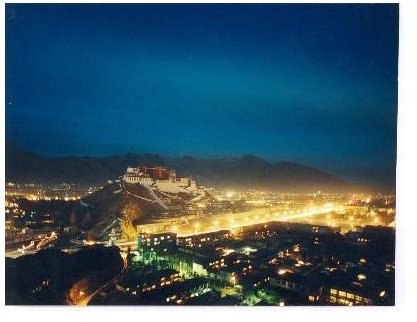Science and Technology in Tibet
Political instability and alarming conflicting interests with neighboring countries are among the dangerous diseases that can affect a nation. Tibet has been a politically unstable country for more than sixty years and remains so today. Even though Tibetans are fighting for their sovereignty and freedom from China’s communist rule, and despite all odds, Tibet has built strong infrastructure. Roads, railway tracks, and high altitude dams have all been built in Tibet in the last few years. The People’s Republic of China has invested heavily in the Tibet autonomous region and has laid down the foundation for the growth in the future.
Water Power Engineering in Tibet
Tibet is located in the lap of the Great Himalayas. Many rivers originate in Tibet, and one of the most famous and resource-filled is the River Sutlej. Another major river is the Yarlung Zangbo River, which becomes the Brahmaputra in India.
Chinese authorities have been assessing the hydropower potential of the country. The Yarlung Zangbo River alone is capable of producing as much as 38-million-KW of hydro-power annually. The government is also planning to assess the hydropower potential of the Lhasa and Ngang Qu rivers. Tibet has huge hydropower potential, and the good news for the industrialists and power companies is that it is yet to be harnessed. Infrastructure, education, and core companies have attracted foreign investments in Tibet. HongKong, the United States, and Japan are some of the major investors in Tibet. Foreign investors can start joint ventures or run wholly owned enterprises.
As far as environmental impacts of the hydropower generation are concerned, rivers and mountains are considered sacred in the country and people pray to them. So for the companies to build successful and operational power plants, complying with the unstated rules of respecting the mountains and rivers becomes an important part of the construction process.
Infrastructure Development in Tibet
A bird’s-eye-view of Lhasa City, the capital of the nation, makes you wonder if you are looking at a practical place on earth or a still from a sci-fi movie.
Not only in Lhasa, but in almost every part of the country, authorities have increased the pace of infrastructure development. In 2007, the economy of Tibet stood at staggering revenue figures of 34.2 billion Yuan ($5.5 billion). Starting from 2000, Tibet’s autonomous region has successfully achieved and maintained an annual growth rate of 12%, which is well above the growth rates of major Chinese cities. In 2008, the authorities approved a huge budget worth 770 billion Yuan under the 11th Five-Year Plan for infrastructure development in the country. The Tibet Autonomous Regional Development and Reform Commission works for the growth and development of the region, allocates resources, and formulates key projects related to infrastructure development.
Transportation System in Tibet
Building good and durable transportation facilities at high altitude regions is always difficult. Tibet, which stands at an average height of

4900 meters, boasts of having the world’s highest railway tracks. The Qinghai-Tibet railway track spans 1956 km and has become world’s highest- and one of the fastest- operational railway routes. There are 675 bridges on this route, which passes through high altitude passes and tunnels. Railways, since their inception, have opened the gates of development and growth wherever they have reached. The trains started running to and from Lhasa in October 2006 and since then transportation system has improved substantially. Five highways, two major airports, and other roads connecting different parts of the country speak of the hard work Tibetans and Chinese government have done in that high altitude region.
Mount Everest brings trekkers, mountaineers, and tourists into the country, and that makes it even more important to develop infrastructure in that country because a major part of the country’s revenue comes from tourism.
Science and technology in Tibet is not limited to the infrastructure and transportation sectors only. Tibetans have successfully merged their ancient medical science with modern age medical practices. Solar and geothermal resources are used on a large scale in the country, and the authorities educate people about the need of saving energy. Many scientific exchange and collaboration programs have been started by the government to provide science exposure to the public. In the field of geothermal energy, Tibet has huge potential and now it is working in collaboration with the United Nations and Japanese experts to build a sustainable geothermal energy model. The Yangbajain Geothermal Field is the main area of research for the experts. The Lhasa Geomagnetic Observatory and Research Institute of Astronomy and Calendar were established to study meteorology and seismic sciences.
In a nutshell, politically unstable Tibet is marching slowly but steadily on the path of growth and development, hand-in-hand with modern technology. It is just like those old days when industrial revolution was round the corner and smart investors were ready with their money to be invested in the right place, at the right time.
References
-
Science and Technology in Tibet, http://www.china-embassy.org/eng/zt/zgxz/Science%20and%20Education/Science/
-
Tibet Autonomous Region, http://www.ipim.gov.mo/worldwide_partner_detail.php?mode=popup&tid=3916&extra=page%3D1&lang=en-us
-
China’s Central Government helps Tibet develop economy and scoiety, http://www.china-un.org/eng/gyzg/xizang/t420200.htm
-
Image
Lhasa View**,** http://www.xzta.gov.cn/yww/Gallery/default.shtml
Qinghai-Tibet Rail Route by Siriudie under public domain, http://en.wikipedia.org/wiki/File:QingZang_Railway.png
-
Railway and China’s Development Strategy In Tibet, http://www.tchrd.org/publications/topical_reports/development_in_tibet/development.pdf
